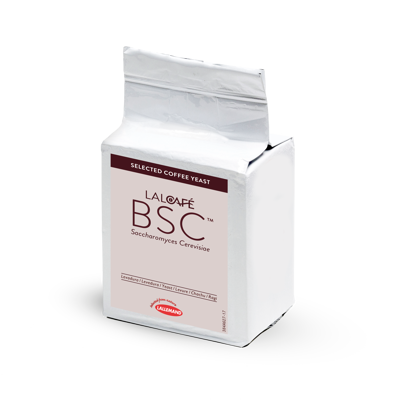LALCAFÉ BSC™

Coffee fermentation can be done using different processing techniques depending on the style being sought after. Cherries can be processed whole or depulped, submerged or dry. In all cases it is important to control the fermentation. The wet process consists of submerging all the pulped coffee beans
Options
| Item No. | Description | Availability | Price | |
|---|---|---|---|---|
| 15678 | LALCAFE BASIC™ Coffee Yeast 500g | 8 in stock | Price $27.5 | Each |
| 15683 | LALCAFE BASIC™ Coffee Yeast 10kg | Backorder Click for ETA | Price $480 | Each |
Description
Coffee fermentation can be done using different processing techniques depending on the style being sought after. Cherries can be processed whole or depulped, submerged or dry. In all cases it is important to control the fermentation. The wet process consists
of submerging all the pulped coffee beans into clean water during a certain time. During this period of maceration (when the coffee beans are under water), two phenomena happen, depending on the duration of the maceration. The first one is demucilagination
and the second is the expression of the sensory characteristics/attributes of the coffee beans. Both steps are commonly called fermentation.
During whole fruit processing, the yeast offers a protective role as it outcompetes the indigenous flora for the food available through the wound of the cherry. Fermentation also takes place hence controlling the process is paramount for green beans with a clean profile. This is a biological process mainly due to yeast action LALCAFÉ BSC™ yeast (Saccharomyces cerevisiae). LALCAFÉ BSC™ has been screened and characterized over a four-year period of research and trials. The results of the trials performed on Arabica and Robusta in different mills around the world confirm that LALCAFÉ BSC™ is really a robust strain and very well suited to better control the fermentation process.
Its specific metabolism and its high capacity of implantation even at cold temperatures (Minimum 15°C inside the coffee tank) allows for a clean fermentation without flavor enhancement.
Downloads
Lalvin BSC - Technical Data Sheet
During whole fruit processing, the yeast offers a protective role as it outcompetes the indigenous flora for the food available through the wound of the cherry. Fermentation also takes place hence controlling the process is paramount for green beans with a clean profile. This is a biological process mainly due to yeast action LALCAFÉ BSC™ yeast (Saccharomyces cerevisiae). LALCAFÉ BSC™ has been screened and characterized over a four-year period of research and trials. The results of the trials performed on Arabica and Robusta in different mills around the world confirm that LALCAFÉ BSC™ is really a robust strain and very well suited to better control the fermentation process.
Its specific metabolism and its high capacity of implantation even at cold temperatures (Minimum 15°C inside the coffee tank) allows for a clean fermentation without flavor enhancement.
Downloads
Lalvin BSC - Technical Data Sheet

LALCAFÉ BSC™
Coffee fermentation can be done using different processing techniques depending on the style being sought after. Cherries can be processed whole or depulped, submerged or dry. In all cases it is important to control the fermentation. The wet process consists
of submerging all the pulped coffee beans into clean water during a certain time. During this period of maceration (when the coffee beans are under water), two phenomena happen, depending on the duration of the maceration. The first one is demucilagination
and the second is the expression of the sensory characteristics/attributes of the coffee beans. Both steps are commonly called fermentation.
During whole fruit processing, the yeast offers a protective role as it outcompetes the indigenous flora for the food available through the wound of the cherry. Fermentation also takes place hence controlling the process is paramount for green beans with a clean profile. This is a biological process mainly due to yeast action LALCAFÉ BSC™ yeast (Saccharomyces cerevisiae). LALCAFÉ BSC™ has been screened and characterized over a four-year period of research and trials. The results of the trials performed on Arabica and Robusta in different mills around the world confirm that LALCAFÉ BSC™ is really a robust strain and very well suited to better control the fermentation process.
Its specific metabolism and its high capacity of implantation even at cold temperatures (Minimum 15°C inside the coffee tank) allows for a clean fermentation without flavor enhancement.
Downloads
Lalvin BSC - Technical Data Sheet
During whole fruit processing, the yeast offers a protective role as it outcompetes the indigenous flora for the food available through the wound of the cherry. Fermentation also takes place hence controlling the process is paramount for green beans with a clean profile. This is a biological process mainly due to yeast action LALCAFÉ BSC™ yeast (Saccharomyces cerevisiae). LALCAFÉ BSC™ has been screened and characterized over a four-year period of research and trials. The results of the trials performed on Arabica and Robusta in different mills around the world confirm that LALCAFÉ BSC™ is really a robust strain and very well suited to better control the fermentation process.
Its specific metabolism and its high capacity of implantation even at cold temperatures (Minimum 15°C inside the coffee tank) allows for a clean fermentation without flavor enhancement.
Downloads
Lalvin BSC - Technical Data Sheet
Options
| Item No. | Description | Availability | Price | |
|---|---|---|---|---|
| 15678 | LALCAFE BASIC™ Coffee Yeast 500g | 8 in stock | Price $27.5 | Each |
| 15683 | LALCAFE BASIC™ Coffee Yeast 10kg | Backorder Click for ETA | Price $480 | Each |
